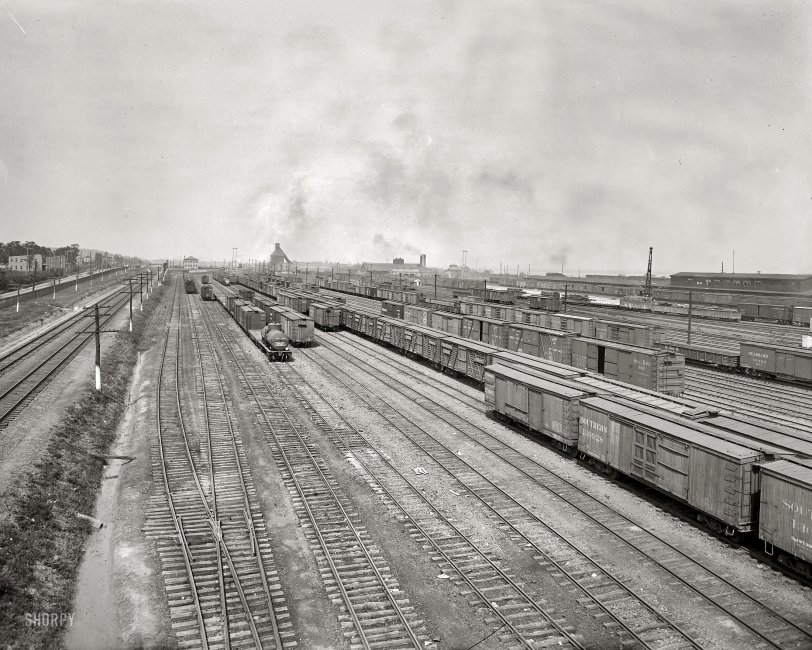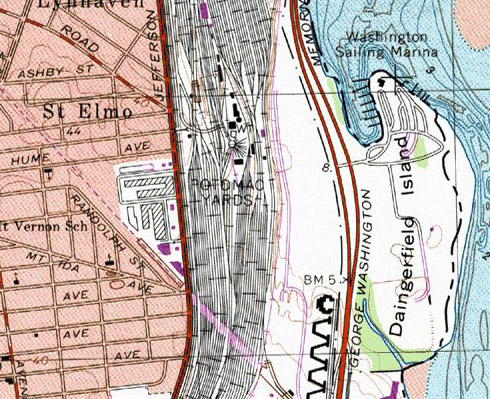


Framed or unframed, desk size to sofa size, printed by us in Arizona and Alabama since 2007. Explore now.
Shorpy is funded by you. Patreon contributors get an ad-free experience.
Learn more.

- Lost in Toyland
- And without gloves
- If I were a blindfolded time traveler
- Smoke Consumer Also Cooks
- Oh that stove!
- Possibly still there?
- What?!?
- $100 Reward
- Freeze Frame
- Texas Flyer wanted
- Just a Year Too Soon
- WWII -- Replacing men with women at the railroad crossing.
- Yes, Icing
- You kids drive me nuts!
- NOT An Easy Job
- I wonder
- Just add window boxes
- Icing Platform?
- Indiana Harbor Belt abides
- Freezing haze
- Corrections (for those who care)
- C&NW at Nelson
- Fallen Flags
- A dangerous job made worse
- Water Stop
- Passenger trains have right of way over freights?
- Coal
- Never ceases to amaze me.
- Still chuggin' (in model form)
- Great shot
Print Emporium
Potomac Yard: 1925

Circa 1925. "Potomac Yards, Alexandria." The railyard just outside Washington in Alexandria, Virginia. National Photo Company glass negative. View full size.
RF&P
My father, Granville A. "Granny" Corr, Jr. worked for the RF&P for over 40 years. Wasn't it referred to as the "richest and smallest" railroad in the country?
Just happened by this site.
Just happened by this site. I wonder if my grandfathers knew yours. Both of mine were also career Southern RR men out of Monroe, Va, two uncles worked for Southern in Alexandria, and 2nd cousin was a conductor with Southern also out of Monroe. Had a great grandfather that also worked on the Southern RR in Monroe too! Small world!
Re: RR Club
That's what I said: "The Southern yard was right about where your desk sits now. There was a small round house and several tracks. There was also at one time a small building housing a club that had an extensive model rail display"
RR Club
The RR club was in the Southern Railway yard behind Herby's Ford on Duke Street, not Potomac Yard. They were there until the early 70's.
Seen in the background here.
Potomac Yards
My father also worked at Potomac Yards, from 1924 to 1963. He was a machinist at the round house. We lived not far from the yards in the Del-Ray section. (DeWitt Ave)
For Wes Clark who works on Dulany Street, that street of course did not exist before the Carlyle project. The Southern yard was right about where your desk sits now. There was a small round house and several tracks. There was also at one time a small building housing a club that had an extensive model rail display.
George "Walt" Gray
Retired fire captain.
Haz-Mat Officer
Station Captain #2 Station, Windsor Ave.
Alexandria VA.
Where?
"Southern rejoined switching in Potomac Yard, although it also maintained its own yard just south of Duke Street, which is totally unrecognizable today as a redeveloped region known as Carlyle"
I work at the Patent Office on Dulany St. Where was this yard, exactly?
Wes Clark
wes.clark@uspto.gov
Whitewash
The whitewashed pole bases were for night visibility. Normally, the lower 6-8 feet of all buildings + poles, especially in the roundhouse area, were whitewashed, including the inside walls of the turntable pit. Incandescent lighting was pretty dim in railroad yards back then, and the whitewash really made a safety difference.
White poles
Why are the utility poles are painted white at the bottom?
Trackless Void
The entire Potomac Yard area is now just big box retailers, chain restaurants and hotels. What's left of the RF&P is just a real estate company.
Southern's use of Potomac Yard
Southern was one of six railroads that managed the yard and its operations. Except during a period in the 1920s when Southern felt the RF&P, which basically managed the yard and its switching, was getting a little too cozy with at least SAL and ACL, giving them preference. At least that was the allegation. Southern then built the Cameron Street yard, which still exists as an intermodal yard for transferring I think LPG. When Southern built this yard, it apparently also enticed the C&O to join, and then the fit hit the shan, so to speak. The Pennsy, which was a co-owner in the yard operations like the other RR's, sued Southern charging breach of contract and other things, and after a year or two of squabbling, all became peaceful again and Southern rejoined switching in Potomac Yard, although it also maintained its own yard just south of Duke Street, which is totally unrecognizable today as a redeveloped region known as Carlyle. This yard had it origins in the 1850's and the beginnings of railroading in the region with the Orange & Alexandria. Supposedly, the reason for the Cameron yard's location was because that was the vicinity of where the never completed Manassas Gap Independent Line was to cross the Orange & Alexandria in the 1850's. Title to the lands passed to descendants of the O&A, which became Southern in 1894.
This may not be 100% of what happened but I have reason to believe it is the basic idea, if you get my drift.
A Local Historian
Monroe to Spencer
Since a couple of comments mention the railroad run from Monroe, Va., to Spencer, N.C., you might like to know that this is the run that is the basis of the folk/bluegrass song "The Wreck of Ole 97," made famous by Flatt & Scruggs.
Where there's smoke
The smoky sky in this and many Shorpy photos is a reminder that not everything about the good old days was so good.
Rails run deep
I'm sure they probably did cross paths at some point. My grandfather (known as "Pa" to us grandchildren) was a brakeman, flagman, and conductor on the Southern from 1908-1950. He lived in Spencer but worked "on the road" for several days a week between Spencer, Monroe, and Washington for 42 years straight. It was hard but honest work. He is sorely missed.
When we sat down to dinner, as only a true brakeman would say, instead of asking "Pass the biscuits" he would routinely say "Knock the brakes off the biscuits, please"!!
Thanks, Dave for showing us a glimpse of the past.
Our Grandfathers
I can't help but wonder if our grandfathers knew each other. My grandfather was a career RR worker and worked at Potomac Yard, transferred to Spencer NC, on to Monroe VA, and then back to Potomac Yard. His career span included 1925.
To answer your question, yes.
Users of Potomac Yard
Railways using Potomac Yard included:
- Pennsylvania Railroad
- Baltimore and Ohio Railroad
- Southern Railway
- Chesapeake and Ohio Railway
- Atlantic Coast Line Railroad, and
- Seaboard Air Line Railway
Potomac Yard in Wikipedia.
My Granddad's Railroad
My grandfather was a brakeman on the Southern Railroad in 1925 on the Spencer, N.C., to Washington run. My question is: Was Potomac Yard used for Southern RR traffic, or was it only for the Richmond, Potomac & Fredericksburg Line?
Re: Dad's Railroad
Hi: I noticed you edited my comments about My Dad's Railroad. That's fine--I appreciate you posting my remembrances, but your inference (re-write) that "RFK Stadium's owners realized the yard was far more commercially viable than any railroad" is absolutely incorrect. RF & P Railroad OWNED THE LAND--not The DC or Federal Government. ...
[Back up a little. Your original comment did not say "RF&P's owners." It said "RFK's owners." - Dave]
Potomac Yard from above
This aerial view from 1975 shows the tower at Hume Street and the man bridge at x East Glebe Road. The W&OD flyover shows at Randolph Street. Until the early 1980s, maybe later, there was a restaurant across Route 1 (locals called it Number 1 or Number 1 Highway), called Steve's, open 24/7 for the Yard workers. Would stop for breakfast on the way home from Georgetown.
Potomac Yard, Stadium, Airport
My former office in Crystal City overlooks the remaining RR yards between CC and National Airport. (not everyone calls it by the current name)
Yes, there was a protest about the stadium being located at the yards, but the real backstory is that Jack Kent Cooke, Redskins owner, played VA, MD and DC like a set of violins until he got was he wanted. The protests were not really a factor in the final decision; Cooke's marionette show did the trick.
Hump Yard
When I was a Boy Scout in the early 1960s we took a tour of Potomac Yards, including a trip to the two-story brick "control tower" in the backbround. Freight cars were pushed by a switcher engine to the top of the hump (a gentle hill) and then cut loose and rolled downhill by gravity, shunted to their particular assembling track by the levers in the control tower. This tower housed all the switches for the entire yard. There were also external air brakes on the side of the rails that could be remotely actuated from the tower to control the speed of the cars.
The employees had to park along Route 1 on the left of the picture and take the pedestrian bridge (seen in the background) over the main line to the control tower.
Click the map to enlarge.
W&OD Flyover
The Washington & Old Dominion RR had a flyover track across Pot Yard here that connected with the Southern Ry. a little farther to the SE of where I think this photo was taken.
My Dad's Railroad
My dad worked at Potomac Yard as a train engineer from the very day he returned from World War II in early 1946 until the very day he retired in 1990. Then saw entire company disappear virtually overnight when the Richmond, Potomac & Fredericksburg line realized the land the yard was on was far more commercially viable than any railroad. The Washington Redskins were going to build their new stadium there and a ground breaking took place. Local residents fought to have the football stadium put elsewhere. They won. And Potomac Yard is now a shopping center with mixed-use residential being now added.
How strange to see Route 1 on the left side of this photo a small, quaint two-way street. Today it bustles with traffic. And although the railroad still moves people and freight along the corridor, the tracks were moved to the the east, next to Metro's above-ground tracks.
Growing up, I spent many hours in Potomac Yard playing on the engines with my father.

























On Shorpy:
Today’s Top 5